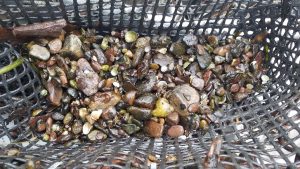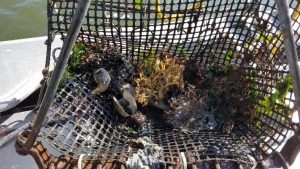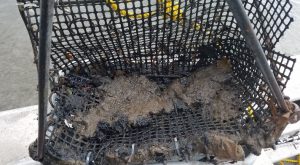There is very little information on the density and or the species of bivalve mollusks present in the watershed of the Raritan River basin. The work that was conducted involved examining the presence or absence of bivalve mollusks from the mouth of the Raritan River to just past the Route 18 bridge in New Brunswick. The initial part of the project involved literature searches for information on the bottom substrate compositions, salinity gradients and previously reported presence of bivalve populations in the Raritan River.

Figure B
The project involved two undergraduates and a graduate student who helped in identification of shells and participated in the project. One of the two undergraduates followed up by taking a course at the Rutgers Bivalve Station over winter break examining bivalve aquaculture techniques.

Figure C
The research team found that at the mouth of the Raritan River the highest diversity of bivalves was present likely due to bottom conditions, reproducing populations of several different species in Raritan Bay, and tidal influences (Figures A, B and C). Substrate types appeared to be a major influence in the ability for the bivalves to colonize an area. The mid-range of the river was heavily impacted by silt (high organic content), fine grain sediments and plant derived litter which was not conducive to bivalve settlement or establishment (Figure D). Hard substrates where present could support oyster spat and barnacle attachments if they were distributed into these areas. The river bottom adjacent to New Brunswick and further north contained large numbers of corbicula shells (Asiatic Clam) from local and upstream populations (Figure E). These clams reside on the surface of the gravel areas in shallow fast flowing areas of the river. Several native freshwater shells were also present along the shoreline indicating populations in or around this area.

Figure A

Figure D
Additional studies need to be carried out to better characterizing areas where populations which may be introduced to reestablish reproducing bivalve populations. Bivalves provide an important source of food for fish and serve to clarify large quantities of water through filter feeding processes. Future work should expand upon this effort concentrating on those areas shown to have bivalves present and attempting to introduce bivalves into the

Figure E
system.
The project team included Keith Cooper, Professor, Department of Biochemistry and Microbiology, and Gina Moreno, PhD student, Department of Environmental Sciences. For more information, contact Dr. Cooper at cooper@aesop.rutgers.edu, or (848) 932-5614. This project was supported by a 2019 Rutgers Raritan River Consortium Mini-grant.